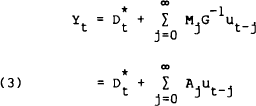RDP 8608: Exchange Rate Regimes and the Volatility, of Financial Prices: The Australian Case 2. The VAR Methodology
July 1986
- Download the Paper 919KB
In general we will be concerned with an (nxl) vector of n endogenous variables Yt containing domestic and foreign financial price variables. We assume that Yt is generated by the mth order vector-autoregression,
where Dt is a (nxl) vector representing the deterministic component of Yt (generally a polynomial in time), Bt are (nxn) matrices and εt is a (nxl) vector of multivariate white noise residuals (or innovations). Equation (1) is specified and estimated as an “unrestricted reduced form”. As is the hallmark of VARs, there are no exclusion restrictions within the Bj matrices. Rather, the Bj's are uniquely determined under the orthogonality conditions E(εt) = 0 and E(Yt−jεt) = 0, j=1, …, m, and are estimated by ordinary least squares. Given the choice of variables in Yt, the only pretesting involved with the fitting of equation (1) is in choosing the appropriate lag length m. In general we choose the smallest m such that εt is indistinguishable from a multivariate white noise process.[7]
Tests which are commonly applied to VARs are tests for Granger-causality which test whether a variable, say Y1t is useful in forecasting another variable, say Y2t. The variable Y1t, is said to be useful in forecasting Y2t if the inclusion of lags of Y1t in the equation for Y2t significantly reduces the forecast variance. Thus it tests whether lags of Y1t contain any additional information on Y2t which is not already contained in the lags of Y2t itself.
The model presented in equation (1) is difficult to describe in terms of the Bj coefficients. The best descriptive devices are the innovation accounting techniques suggested in Sims (1980, p.21) and described by Litterman (1979, pp.74–85). The first of these techniques of innovation accounting are the impulse response functions which describe the dynamic response of variables in the VAR to an impulse in one of the variables. To understand these impulse response functions, consider the moving average representation of equation (1), obtained by repeated back substitution for Yt−1,
where Mj is a (nxn) matrix of moving average coefficients. The response of the ith
variable to a unit innovation in the kth variable j periods earlier is given by the
ikth element of Mj. In general, however, there is likely to be some
contemporaneous correlation among innovations, which is not taken into account in equation (2).
If one can assume some contemporaneous causal ordering of the variables in Yt (such
that contemporaneous causality is one way, i.e., recursive) one can obtain orthogonalised
innovations ut, where ut = Gεt, so that E(ut ) = ϕ
where ϕ is a diagonal (nxn) matrix. For example, if we have a VAR with a foreign variable
and a domestic variable and assume that the domestic variable does not contemporaneously cause
the foreign variable, then the foreign variable will be ordered above the domestic variable in Yt
and G will be of the form,
) = ϕ
where ϕ is a diagonal (nxn) matrix. For example, if we have a VAR with a foreign variable
and a domestic variable and assume that the domestic variable does not contemporaneously cause
the foreign variable, then the foreign variable will be ordered above the domestic variable in Yt
and G will be of the form,
where ρ is the estimated coefficient in the regression equation,
ε1t is the innovation in the foreign variable, ε2t the innovation in the domestic variable and u2t the orthogonalised innovation in the domestic variable (in the sense that it is orthogonal to u1t = ε1t).
In terms of orthogonalised innovations, ut, the moving average representation is,
where the ikth element of Aj gives the response of variable i to an orthogonalised unit impulse in variable k, j periods earlier.
For the purposes of this paper, however, the second device of innovation accounting will be used. This relates to the decomposition of the k-step ahead forecast variance of each variable in the VAR, into percentages contributed by the innovations in each variable. A variable whose own innovations account for all or most of its own forecast variance would be said to be exogenous (in the Sims sense) to the system.
The k-step ahead forecast variance may best be seen by considering the k-step ahead forecast error induced by forecasting Yt linearly from its own past,
(in terms of orthogonalised innovations) where Et (Yt+k) is the linear least squares forecast of Yt+k given all information at time t. The k-step ahead forecast variance is,
Because of the extensive orthogonality conditions built into the model, the k-step ahead forecast variance of each variable will be a weighted sum of the variances of the innovations to each variable. Thus we can obtain the percentage contribution of each variable's innovations to the variance of any other variable.
Footnote
On the basis of tests for within, and across, equation serial correlation and tests for the significance of Bm, from the zero matrix. The inverse autocorrelation function (i.e., the autocorrelation function of the dual model) is used to test for non-stationarity of the residuals. (See, for example, Priestley (1981).) All of the empirical work is done using the macro facilities of version 5 of SAS. [7]






